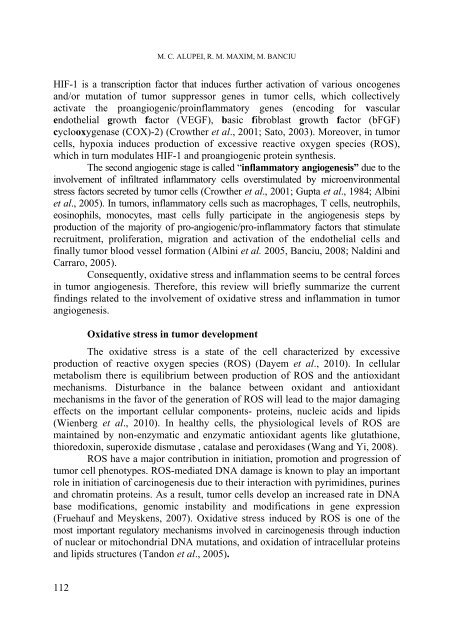biologia - Studia
biologia - Studia
biologia - Studia
You also want an ePaper? Increase the reach of your titles
YUMPU automatically turns print PDFs into web optimized ePapers that Google loves.
M. C. ALUPEI, R. M. MAXIM, M. BANCIU<br />
HIF-1 is a transcription factor that induces further activation of various oncogenes<br />
and/or mutation of tumor suppressor genes in tumor cells, which collectively<br />
activate the proangiogenic/proinflammatory genes (encoding for vascular<br />
endothelial growth factor (VEGF), basic fibroblast growth factor (bFGF)<br />
cyclooxygenase (COX)-2) (Crowther et al., 2001; Sato, 2003). Moreover, in tumor<br />
cells, hypoxia induces production of excessive reactive oxygen species (ROS),<br />
which in turn modulates HIF-1 and proangiogenic protein synthesis.<br />
The second angiogenic stage is called “inflammatory angiogenesis” due to the<br />
involvement of infiltrated inflammatory cells overstimulated by microenvironmental<br />
stress factors secreted by tumor cells (Crowther et al., 2001; Gupta et al., 1984; Albini<br />
et al., 2005). In tumors, inflammatory cells such as macrophages, T cells, neutrophils,<br />
eosinophils, monocytes, mast cells fully participate in the angiogenesis steps by<br />
production of the majority of pro-angiogenic/pro-inflammatory factors that stimulate<br />
recruitment, proliferation, migration and activation of the endothelial cells and<br />
finally tumor blood vessel formation (Albini et al. 2005, Banciu, 2008; Naldini and<br />
Carraro, 2005).<br />
Consequently, oxidative stress and inflammation seems to be central forces<br />
in tumor angiogenesis. Therefore, this review will briefly summarize the current<br />
findings related to the involvement of oxidative stress and inflammation in tumor<br />
angiogenesis.<br />
Oxidative stress in tumor development<br />
The oxidative stress is a state of the cell characterized by excessive<br />
production of reactive oxygen species (ROS) (Dayem et al., 2010). In cellular<br />
metabolism there is equilibrium between production of ROS and the antioxidant<br />
mechanisms. Disturbance in the balance between oxidant and antioxidant<br />
mechanisms in the favor of the generation of ROS will lead to the major damaging<br />
effects on the important cellular components- proteins, nucleic acids and lipids<br />
(Wienberg et al., 2010). In healthy cells, the physiological levels of ROS are<br />
maintained by non-enzymatic and enzymatic antioxidant agents like glutathione,<br />
thioredoxin, superoxide dismutase , catalase and peroxidases (Wang and Yi, 2008).<br />
ROS have a major contribution in initiation, promotion and progression of<br />
tumor cell phenotypes. ROS-mediated DNA damage is known to play an important<br />
role in initiation of carcinogenesis due to their interaction with pyrimidines, purines<br />
and chromatin proteins. As a result, tumor cells develop an increased rate in DNA<br />
base modifications, genomic instability and modifications in gene expression<br />
(Fruehauf and Meyskens, 2007). Oxidative stress induced by ROS is one of the<br />
most important regulatory mechanisms involved in carcinogenesis through induction<br />
of nuclear or mitochondrial DNA mutations, and oxidation of intracellular proteins<br />
and lipids structures (Tandon et al., 2005).<br />
112
















